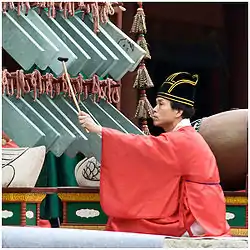Fangxiang
The fangxiang (also fang xiang, fang hsiang; 方响 or 方響 in Chinese, pinyin: fāngxiǎng; also known in the West as the Chinese chang[2]) is an organized-suspended (bianxuan) Chinese metallophone that has been used for over 1,000 years. Fangxiang is the only instrument type that is found in the Stone category of the eight sounds. It was first used in the Liang Dynasty (502—557 CE), and then standardized in the Sui and Tang dynasties mostly for court music.[3]
 | |
| Stone | |
|---|---|
| Classification | metallophone |
| Hornbostel–Sachs classification | 111.222 (Percussion) |
| Developed | 502—557 (Liang Dynasty) |
| Related instruments | |
| banghyang, hōkyō (kanji: 方響).[1] | |
Construction and Design
Stones in the ancient sets are (like the bells) usually of similar thickness but of graded size.[3] It consists of 16 iron, bronze or jewel tuned rectangular slabs with 16 different pitches, laid in a frame in two rows and usually constructed in L-shape.[3] The slabs are struck with a hammer and played melodically. Unlike the metallophone today, Chinese changed the thickness of the metal plates to get different pitches.[4] Each of the slabs is of the same length and width but they are of graduated thickness, with the thinner slabs producing lower tones and the thicker slabs producing higher tones.[1]
History
In ancient times, the fangxiang was a popular instrument in Chinese court music. It was introduced to Korea, where it is called banghyang (hangul: 방향; hanja: 方響) and is still used in the court music of Korea. A similar instrument used in Japan is called the hōkyō (kanji: 方響).[1] The first time that fangxiang shown up in Liang Period in the Northern and Southern Period (502-557). During Sui and Tang dynasties (581-840), the instrument got developed and became popular in the court. There were many famous fangxiang performers at that time, including Xianqi Ma and Bing Wu. Also at that time, there were many poets making ancient Chinese poems to accompany with the fangxiang performance.
Music contribution
In the 1980s, the fangxiang was expanded to include 51 soundboards. The soundboards were arranged based on twelve-tone equal temperament and double scale arrangement. On the top lane, it is the C# scale, and on the bottom lane it is the C major scale ranging from f to C4. The shelf used for holding those soundboards can rise up and fall down for the convenience of performing. The new design of the fangxiang sounds clear and melodious, and it is really good for accompaniments in the Chinese traditional orchestra music. For example, in the music "The Great Wall Cappricio",[5] it is used to sound like a bell.
International development
The fangxiang was used by the American composer Lou Harrison in his Music for Violin with Various Instruments: European, Asian and African (1967, revised 1969). Harrison had taken research trips to Japan and South Korea (1961) and Taiwan (1962).[1]
References
- "Fangxiang (方响)." - China Culture. N.p., n.d. Web. 17 Sept. 2013. <"Archived copy". Archived from the original on 2014-01-03. Retrieved 2013-09-17.CS1 maint: archived copy as title (link)>.
- Scholes, Percy. The Oxford Companion To Music (1956 ed.). Oxford University Press. p. 481.
- Thrasher, Alan (2000). Chinese Musical Instruments. New York: Oxford University Press Inc. p. 16. ISBN 0-19--590777-9.
- "Marching to the beat of a Chinese drum". Archived from the original on 27 September 2013. Retrieved 23 September 2013.
- Wong On-yuen,Chen Tscheng-hsiung, and China Central National Orchestra (1994). The World of Wong On-yuen's Hu Qin Music Vol.10 - Concerto for Erhu "The Great Wall Capriccio" (MP3). Linfair Records / R2G Music. ASIN B005M1DUPE.
